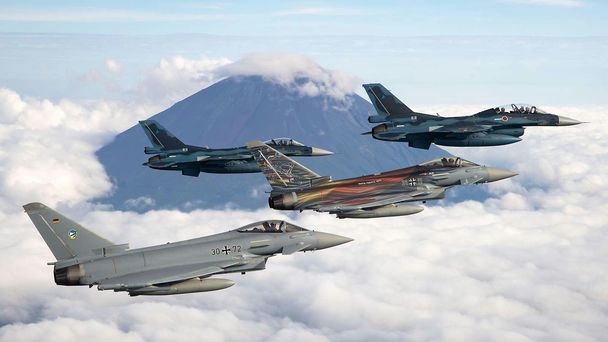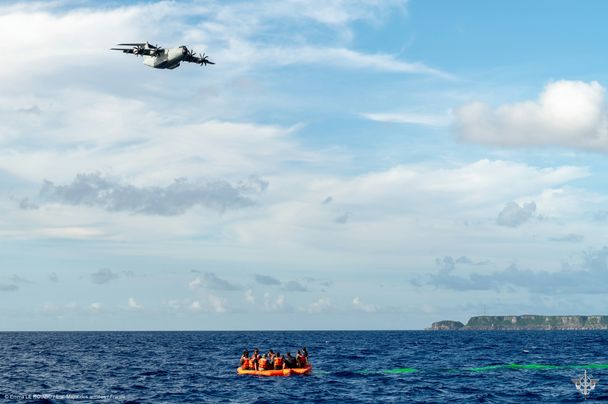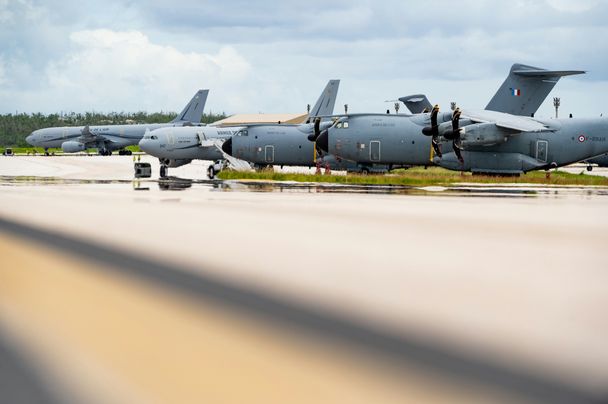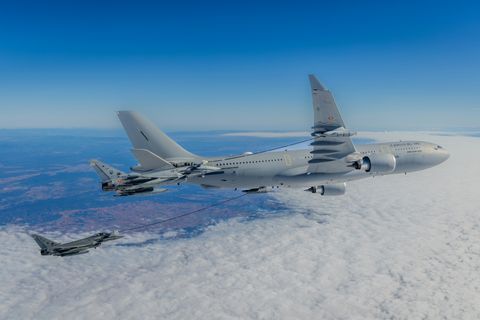Pacific Skies 2024: Airbus military aircraft lead record joint airlift deployment in the Asia-Pacific region

More than 1,800 German, French and Spanish military personnel aboard nine Airbus A400Ms, six A330 MRTTs, 12 Eurofighters, 12 Tornados, one A330-200 and four H145M helicopters will take part in an historic exercise across the Asia-Pacific region in icy, desert and tropical environments.
The 58,000-kilometre odyssey, featuring countless stops across four continents between 27 June and 15 August, has four highlights: Arctic Defender in Alaska, Nippon Skies in Japan, Pitch Black in Australia and Tarang Shakti 1 in India.
With this deployment, the three nations involved in the Future Combat Air System (FCAS) aim to increase their operational capability, strengthen military cooperation with countries in the Indo-Pacific region and demonstrate their air power and dedication to the region.
“By participating in Pacific Skies 24, we as Europeans are showing presence in a part of the world that is of great importance to all of us,” says Luftwaffe Chief of Staff Lieutenant General Ingo Gerhartz.

“We expect Russian planes to intercept us”
For the first time in its recent history, the Spanish Air and Space Force is participating in a project of these characteristics, with a level of ambition similar to that of the pioneering Spanish aviators who crossed the Atlantic Ocean in the 1920s. In this case, the contingent will be made up of four Eurofighters, from the 11th and 14th Wings, two A400Ms from the 31st Wing and one A330-200 from the 45th Group, as well as 240 military personnel in two rotations.
The most critical stretch, according to the head of Spanish Air Combat Command Chief, Lieutenant General Francisco González-Espresati, will be between Alaska and Japan, when the European aircrews will fly over the Pacific Ocean, close to Russian airspace. “It is envisaged that Russian aircraft will approach and intercept us,” he said. “We’re pretty sure they will, but we’re not worried about it.”
Among the exercise milestones for the Spanish A400Ms are the return of an aircraft from Alaska over the North Pole, while a trip with French and Germans to New Zealand, the antipode of Spain, also stands out.

In Australia, during the Pitch Black exercise, the most experienced Spanish Air and Space Force pilots will train in non-NATO environments with 20 different types of aircraft from 20 countries.
In the final stage, the “Tarang Shakti Phase 1” exercise in India, pilots will face Indian fighters ‘made in Russia’, with which the Spanish pilots have no direct experience.

Shared maintenance of A400Ms and Eurofighters between Germany and Spain
With the aim of having the smallest logistical footprint and maximum performance, the Spanish Air and Space Force and the German Luftwaffe will carry out shared maintenance of their Eurofighters and A400Ms as a perfect example of interoperability and cooperation between allied nations.
Throughout the seven-week expedition, Spaniards and Germans will work side by side. Both air forces will depart from Cologne, Germany, and NATO A330 MRTT MMFs, led by Germany, will refuel the Spanish fighters throughout the mission.
As a first responder, and in addition to the four A330 MRTTs from MMF, the German Air Force will rapidly and flexibly deploy four A400Ms, eight Eurofighters, 12 Tornados and four H145M helicopters. This will be the Tornado’s last appearance on an international stage. First with low-level training in Alaska and, in early July, in Arctic Defender, a German-led, air-to-air combat exercise, which will also include Spanish, French and US forces, including fifth-generation fighters and live ammunition.
In Japan, German Eurofighters will train for the first time in Japanese airspace, taking part in the Nippon Skies exercise. Afterwards, the German deployment will be split between Hawaii, where the Rimpac exercise is taking place, together with the German Navy, and Australia for Pitch Black, together with the French and Spanish forces. Their last exercise will be Tarang Shakti 1, in India, with the Indian Air Force and UK RAF.

An A400M ‘saviour’ and an A330 MRTT connected to the HQ
Throughout the journey, aircraft of the three armed forces will be accompanied by a French A400M, which will perform Search and Rescue duties in the event of an emergency.
An A330 MRTT will be linked via satellite to the headquarters in Lyon, south-east France, from where all French operations will be controlled.
One part of the French fleet, consisting of three Airbus A400Ms and three Airbus A330 MRTT 'Phénix', as well as four Rafales, will participate alongside Spanish and German forces in Pacific Skies, with key stops in Alaska, Japan, Australia and India and also passing through Canada, New Zealand, Malaysia and the United Arab Emirates, among others.
The other part of the contingent is part of Griffith Strike, in which three A330 MRTTs and three A400Ms - plus three Rafales - from the French Air and Space Force, accompanied by the UK Royal Air Force, will travel to Australia, via the United Arab Emirates and Singapore.
The French deployment aims to be extremely fast and agile, for this reason, its A400Ms and A330 MRTTs will be responsible for carrying all the necessary material, reducing the logistical footprint and without the need to send equipment in advance or by ship.

Airbus team at the service of the customer
At each of the stops, with each of the air forces, an Airbus Services team will be supporting the readiness of the aircraft at all times, regardless of weather conditions or mission characteristics, including low-altitude flying, air strikes, air defence and refuelling.
“Pacific Skies is both a great opportunity and a challenge for the Airbus Services team as it is an exercise of unprecedented complexity and intensity,” said Geraldine Thiercelin, Head of Services at Air Power, Airbus Defence and Space. “We are working very closely with our suppliers and have prepared additional material and sent technical experts to provide on-site support to respond to the needs that air forces may have at any time during the deployment.”
Pacific Skies is a demonstration of Europe’s strategic autonomy capability in a complex geopolitical context, where air power and interoperability of allied forces are essential.



